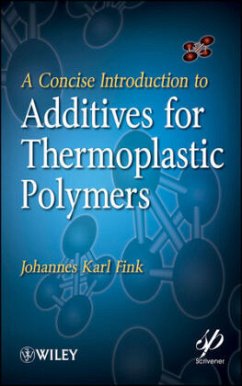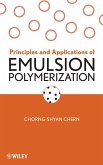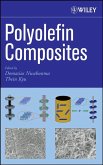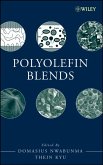Johannes Fink
A Concise Introduction to Additives for Thermoplastic Polymers
Johannes Fink
A Concise Introduction to Additives for Thermoplastic Polymers
- Gebundenes Buch
- Merkliste
- Auf die Merkliste
- Bewerten Bewerten
- Teilen
- Produkt teilen
- Produkterinnerung
- Produkterinnerung
This reference focuses on additives for thermoplastic polymers and describes 21 of the most important and commonly used additives from Plasticizers and Fillers to Optical Brighteners and Anti-Microbial additives. It also includes chapters on safety and hazards, and prediction of service time models. Written in an accessible and practical style, A Concise Introduction to Additives for Thermoplastic Polymers is the ideal primer for students who will later work in polymer science or the development of plastics formulation, as well as industry engineers and specialists who need a deeper knowledge of the plastics industry.…mehr
Andere Kunden interessierten sich auch für
![Organic and Physical Chemistry of Polymers Organic and Physical Chemistry of Polymers]() Yves GnanouOrganic and Physical Chemistry of Polymers174,99 €
Yves GnanouOrganic and Physical Chemistry of Polymers174,99 €![Emulsion Polymerization Emulsion Polymerization]() Chorng-Shyan ChernEmulsion Polymerization194,99 €
Chorng-Shyan ChernEmulsion Polymerization194,99 €![Plastics Materials and Processes Plastics Materials and Processes]() Charles A. HarperPlastics Materials and Processes224,99 €
Charles A. HarperPlastics Materials and Processes224,99 €![Polyolefin Blends and Composites, 2 Volume Set Polyolefin Blends and Composites, 2 Volume Set]() Polyolefin Blends and Composites, 2 Volume Set436,99 €
Polyolefin Blends and Composites, 2 Volume Set436,99 €![Handbook of Engineering and Specialty Thermoplastics, Volume 2 Handbook of Engineering and Specialty Thermoplastics, Volume 2]() Johannes K. FinkHandbook of Engineering and Specialty Thermoplastics, Volume 2259,99 €
Johannes K. FinkHandbook of Engineering and Specialty Thermoplastics, Volume 2259,99 €![Polyolefin Composites Polyolefin Composites]() Polyolefin Composites271,99 €
Polyolefin Composites271,99 €![Polyolefin Blends Polyolefin Blends]() Polyolefin Blends268,99 €
Polyolefin Blends268,99 €-
-
-
This reference focuses on additives for thermoplastic polymers and describes 21 of the most important and commonly used additives from Plasticizers and Fillers to Optical Brighteners and Anti-Microbial additives. It also includes chapters on safety and hazards, and prediction of service time models. Written in an accessible and practical style, A Concise Introduction to Additives for Thermoplastic Polymers is the ideal primer for students who will later work in polymer science or the development of plastics formulation, as well as industry engineers and specialists who need a deeper knowledge of the plastics industry.
Hinweis: Dieser Artikel kann nur an eine deutsche Lieferadresse ausgeliefert werden.
Hinweis: Dieser Artikel kann nur an eine deutsche Lieferadresse ausgeliefert werden.
Produktdetails
- Produktdetails
- Wiley-Scrivener
- Verlag: Wiley & Sons
- 1. Auflage
- Seitenzahl: 282
- Erscheinungstermin: 31. Dezember 2014
- Englisch
- Abmessung: 242mm x 162mm x 23mm
- Gewicht: 530g
- ISBN-13: 9780470609552
- ISBN-10: 0470609559
- Artikelnr.: 30602298
- Herstellerkennzeichnung
- Libri GmbH
- Europaallee 1
- 36244 Bad Hersfeld
- 06621 890
- Wiley-Scrivener
- Verlag: Wiley & Sons
- 1. Auflage
- Seitenzahl: 282
- Erscheinungstermin: 31. Dezember 2014
- Englisch
- Abmessung: 242mm x 162mm x 23mm
- Gewicht: 530g
- ISBN-13: 9780470609552
- ISBN-10: 0470609559
- Artikelnr.: 30602298
- Herstellerkennzeichnung
- Libri GmbH
- Europaallee 1
- 36244 Bad Hersfeld
- 06621 890
JOHANNES KARL FINK is Professor of Macromolecular Chemistry at Montanuniversität, Loebem Austria. His career spans more than 30 years in the fields of polymers, including characterization, flame retardancy, and pyrolysis of polymers.
1 Introduction.
1.1 Classification.
References.
2 Plasticizers.
2.1 Principle of Action.
2.2 Principle of Selection.
2.3 Characterization.
2.4 Risks and Drawbacks.
2.5 Classes of Plasticizers.
2.6 Specific Examples of Application.
References.
3 Fillers.
3.1 Surface Modification.
3.2 Special Applications.
References.
4 Colorants.
4.1 Physics Behind a Color.
4.2 Color Index.
4.3 Test Standards.
4.4 Pigments.
4.5 Organic Colorants.
References.
5 Optical Brighteners.
5.1 Basic Principles.
5.2 Measurement.
5.3 Inorganic Brighteners.
5.4 Organic Optical Brighteners.
References.
6 Antimicrobial Additives.
6.1 Modes of Action.
6.2 Plasticizers.
6.3 Special Formulations.
References.
7 Flame Retardants.
7.1 Mechanisms of Flame Retardants.
7.2 Smoke Suppressants.
7.3 Admixed Additives.
7.4 Bonded Additives.
References.
8 Lubricants.
8.1 Principle of Action.
8.2 Methods of Incorporation.
8.3 Types of Lubricants.
8.4 Special Applications.
References.
9 Antistatic Additives.
9.1 Types of Additives.
9.2 Areas of Application.
9.3 Additives in Detail.
References.
10 Slip Agents.
10.1 Basic Principles of Action.
10.2 Compounds.
10.3 Special Formulations.
References.
11 Surface Improvers.
11.1 Additives.
References.
12 Nucleating Agents.
12.1 Crystalline Polymers.
12.2 Experimental Methods.
12.3 Classes of Nucleating Agents.
12.4 Crystallization Accelerators.
12.5 Clarifying Agents.
References.
13 Antifogging Additives.
13.1 Field of Use.
13.2 Principles of Action.
13.3 Conventional Compounds.
13.4 Compounds for Grafting.
References.
14 Antiblocking Additives.
14.1 Examples of Uses.
References.
15 Hydrolysis.
15.1 Hydrolytic Degradation.
15.2 Polymers.
References.
16 Dehydrochlorination Stabilizers.
16.1 Dehydrochlorination of PVC.
16.2 Stabilizers.
16.2.1Alkyl Tin Compounds.
References.
17 Acid Scavengers.
17.1 Acid Scavenging.
17.2 Examples of Formulation.
References.
18 Metal Deactivators.
18.1 Action of Metals in Polymers.
18.2 Usage.
18.3 Examples of Metal Deactivators.
References.
19 Oxidative Degradation.
19.1 Autoxidation.
19.2 Inhibition of Autoxidation.
References.
20 Degradation by Light.
20.1 Photolysis.
20.2 Photooxdation.
20.3 UV Stabilizers.
References.
21 Blowing Agents.
21.1 Blowing Agents.
21.2 Ozone Depletion Potential.
21.3 Test Methods.
21.4 Special Applications.
References.
22 Compatibilizers.
22.1 Estimation of Compatibility.
22.2 Compatibilizers.
22.3 Special Examples.
References.
23 Prediction of Service Time.
23.1 Accelerated Aging.
23.2 Theory of Critical Distances.
23.3 Monte Carlo Methods.
23.4 Issues in Matrix Composites.
References.
24 Safety and Hazards.
24.1 Plasticizers.
24.2 Flame Retardants.
24.3 Antifogging Agents.
24.4 Other.
References.
Index.
Acronyms.
Chemicals.
General Index.
1.1 Classification.
References.
2 Plasticizers.
2.1 Principle of Action.
2.2 Principle of Selection.
2.3 Characterization.
2.4 Risks and Drawbacks.
2.5 Classes of Plasticizers.
2.6 Specific Examples of Application.
References.
3 Fillers.
3.1 Surface Modification.
3.2 Special Applications.
References.
4 Colorants.
4.1 Physics Behind a Color.
4.2 Color Index.
4.3 Test Standards.
4.4 Pigments.
4.5 Organic Colorants.
References.
5 Optical Brighteners.
5.1 Basic Principles.
5.2 Measurement.
5.3 Inorganic Brighteners.
5.4 Organic Optical Brighteners.
References.
6 Antimicrobial Additives.
6.1 Modes of Action.
6.2 Plasticizers.
6.3 Special Formulations.
References.
7 Flame Retardants.
7.1 Mechanisms of Flame Retardants.
7.2 Smoke Suppressants.
7.3 Admixed Additives.
7.4 Bonded Additives.
References.
8 Lubricants.
8.1 Principle of Action.
8.2 Methods of Incorporation.
8.3 Types of Lubricants.
8.4 Special Applications.
References.
9 Antistatic Additives.
9.1 Types of Additives.
9.2 Areas of Application.
9.3 Additives in Detail.
References.
10 Slip Agents.
10.1 Basic Principles of Action.
10.2 Compounds.
10.3 Special Formulations.
References.
11 Surface Improvers.
11.1 Additives.
References.
12 Nucleating Agents.
12.1 Crystalline Polymers.
12.2 Experimental Methods.
12.3 Classes of Nucleating Agents.
12.4 Crystallization Accelerators.
12.5 Clarifying Agents.
References.
13 Antifogging Additives.
13.1 Field of Use.
13.2 Principles of Action.
13.3 Conventional Compounds.
13.4 Compounds for Grafting.
References.
14 Antiblocking Additives.
14.1 Examples of Uses.
References.
15 Hydrolysis.
15.1 Hydrolytic Degradation.
15.2 Polymers.
References.
16 Dehydrochlorination Stabilizers.
16.1 Dehydrochlorination of PVC.
16.2 Stabilizers.
16.2.1Alkyl Tin Compounds.
References.
17 Acid Scavengers.
17.1 Acid Scavenging.
17.2 Examples of Formulation.
References.
18 Metal Deactivators.
18.1 Action of Metals in Polymers.
18.2 Usage.
18.3 Examples of Metal Deactivators.
References.
19 Oxidative Degradation.
19.1 Autoxidation.
19.2 Inhibition of Autoxidation.
References.
20 Degradation by Light.
20.1 Photolysis.
20.2 Photooxdation.
20.3 UV Stabilizers.
References.
21 Blowing Agents.
21.1 Blowing Agents.
21.2 Ozone Depletion Potential.
21.3 Test Methods.
21.4 Special Applications.
References.
22 Compatibilizers.
22.1 Estimation of Compatibility.
22.2 Compatibilizers.
22.3 Special Examples.
References.
23 Prediction of Service Time.
23.1 Accelerated Aging.
23.2 Theory of Critical Distances.
23.3 Monte Carlo Methods.
23.4 Issues in Matrix Composites.
References.
24 Safety and Hazards.
24.1 Plasticizers.
24.2 Flame Retardants.
24.3 Antifogging Agents.
24.4 Other.
References.
Index.
Acronyms.
Chemicals.
General Index.
1 Introduction.
1.1 Classification.
References.
2 Plasticizers.
2.1 Principle of Action.
2.2 Principle of Selection.
2.3 Characterization.
2.4 Risks and Drawbacks.
2.5 Classes of Plasticizers.
2.6 Specific Examples of Application.
References.
3 Fillers.
3.1 Surface Modification.
3.2 Special Applications.
References.
4 Colorants.
4.1 Physics Behind a Color.
4.2 Color Index.
4.3 Test Standards.
4.4 Pigments.
4.5 Organic Colorants.
References.
5 Optical Brighteners.
5.1 Basic Principles.
5.2 Measurement.
5.3 Inorganic Brighteners.
5.4 Organic Optical Brighteners.
References.
6 Antimicrobial Additives.
6.1 Modes of Action.
6.2 Plasticizers.
6.3 Special Formulations.
References.
7 Flame Retardants.
7.1 Mechanisms of Flame Retardants.
7.2 Smoke Suppressants.
7.3 Admixed Additives.
7.4 Bonded Additives.
References.
8 Lubricants.
8.1 Principle of Action.
8.2 Methods of Incorporation.
8.3 Types of Lubricants.
8.4 Special Applications.
References.
9 Antistatic Additives.
9.1 Types of Additives.
9.2 Areas of Application.
9.3 Additives in Detail.
References.
10 Slip Agents.
10.1 Basic Principles of Action.
10.2 Compounds.
10.3 Special Formulations.
References.
11 Surface Improvers.
11.1 Additives.
References.
12 Nucleating Agents.
12.1 Crystalline Polymers.
12.2 Experimental Methods.
12.3 Classes of Nucleating Agents.
12.4 Crystallization Accelerators.
12.5 Clarifying Agents.
References.
13 Antifogging Additives.
13.1 Field of Use.
13.2 Principles of Action.
13.3 Conventional Compounds.
13.4 Compounds for Grafting.
References.
14 Antiblocking Additives.
14.1 Examples of Uses.
References.
15 Hydrolysis.
15.1 Hydrolytic Degradation.
15.2 Polymers.
References.
16 Dehydrochlorination Stabilizers.
16.1 Dehydrochlorination of PVC.
16.2 Stabilizers.
16.2.1Alkyl Tin Compounds.
References.
17 Acid Scavengers.
17.1 Acid Scavenging.
17.2 Examples of Formulation.
References.
18 Metal Deactivators.
18.1 Action of Metals in Polymers.
18.2 Usage.
18.3 Examples of Metal Deactivators.
References.
19 Oxidative Degradation.
19.1 Autoxidation.
19.2 Inhibition of Autoxidation.
References.
20 Degradation by Light.
20.1 Photolysis.
20.2 Photooxdation.
20.3 UV Stabilizers.
References.
21 Blowing Agents.
21.1 Blowing Agents.
21.2 Ozone Depletion Potential.
21.3 Test Methods.
21.4 Special Applications.
References.
22 Compatibilizers.
22.1 Estimation of Compatibility.
22.2 Compatibilizers.
22.3 Special Examples.
References.
23 Prediction of Service Time.
23.1 Accelerated Aging.
23.2 Theory of Critical Distances.
23.3 Monte Carlo Methods.
23.4 Issues in Matrix Composites.
References.
24 Safety and Hazards.
24.1 Plasticizers.
24.2 Flame Retardants.
24.3 Antifogging Agents.
24.4 Other.
References.
Index.
Acronyms.
Chemicals.
General Index.
1.1 Classification.
References.
2 Plasticizers.
2.1 Principle of Action.
2.2 Principle of Selection.
2.3 Characterization.
2.4 Risks and Drawbacks.
2.5 Classes of Plasticizers.
2.6 Specific Examples of Application.
References.
3 Fillers.
3.1 Surface Modification.
3.2 Special Applications.
References.
4 Colorants.
4.1 Physics Behind a Color.
4.2 Color Index.
4.3 Test Standards.
4.4 Pigments.
4.5 Organic Colorants.
References.
5 Optical Brighteners.
5.1 Basic Principles.
5.2 Measurement.
5.3 Inorganic Brighteners.
5.4 Organic Optical Brighteners.
References.
6 Antimicrobial Additives.
6.1 Modes of Action.
6.2 Plasticizers.
6.3 Special Formulations.
References.
7 Flame Retardants.
7.1 Mechanisms of Flame Retardants.
7.2 Smoke Suppressants.
7.3 Admixed Additives.
7.4 Bonded Additives.
References.
8 Lubricants.
8.1 Principle of Action.
8.2 Methods of Incorporation.
8.3 Types of Lubricants.
8.4 Special Applications.
References.
9 Antistatic Additives.
9.1 Types of Additives.
9.2 Areas of Application.
9.3 Additives in Detail.
References.
10 Slip Agents.
10.1 Basic Principles of Action.
10.2 Compounds.
10.3 Special Formulations.
References.
11 Surface Improvers.
11.1 Additives.
References.
12 Nucleating Agents.
12.1 Crystalline Polymers.
12.2 Experimental Methods.
12.3 Classes of Nucleating Agents.
12.4 Crystallization Accelerators.
12.5 Clarifying Agents.
References.
13 Antifogging Additives.
13.1 Field of Use.
13.2 Principles of Action.
13.3 Conventional Compounds.
13.4 Compounds for Grafting.
References.
14 Antiblocking Additives.
14.1 Examples of Uses.
References.
15 Hydrolysis.
15.1 Hydrolytic Degradation.
15.2 Polymers.
References.
16 Dehydrochlorination Stabilizers.
16.1 Dehydrochlorination of PVC.
16.2 Stabilizers.
16.2.1Alkyl Tin Compounds.
References.
17 Acid Scavengers.
17.1 Acid Scavenging.
17.2 Examples of Formulation.
References.
18 Metal Deactivators.
18.1 Action of Metals in Polymers.
18.2 Usage.
18.3 Examples of Metal Deactivators.
References.
19 Oxidative Degradation.
19.1 Autoxidation.
19.2 Inhibition of Autoxidation.
References.
20 Degradation by Light.
20.1 Photolysis.
20.2 Photooxdation.
20.3 UV Stabilizers.
References.
21 Blowing Agents.
21.1 Blowing Agents.
21.2 Ozone Depletion Potential.
21.3 Test Methods.
21.4 Special Applications.
References.
22 Compatibilizers.
22.1 Estimation of Compatibility.
22.2 Compatibilizers.
22.3 Special Examples.
References.
23 Prediction of Service Time.
23.1 Accelerated Aging.
23.2 Theory of Critical Distances.
23.3 Monte Carlo Methods.
23.4 Issues in Matrix Composites.
References.
24 Safety and Hazards.
24.1 Plasticizers.
24.2 Flame Retardants.
24.3 Antifogging Agents.
24.4 Other.
References.
Index.
Acronyms.
Chemicals.
General Index.








